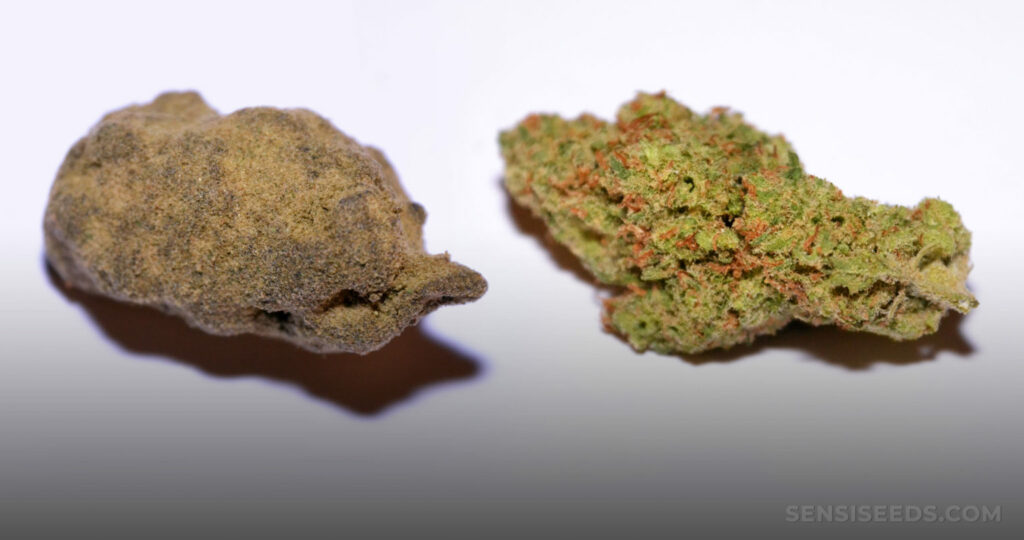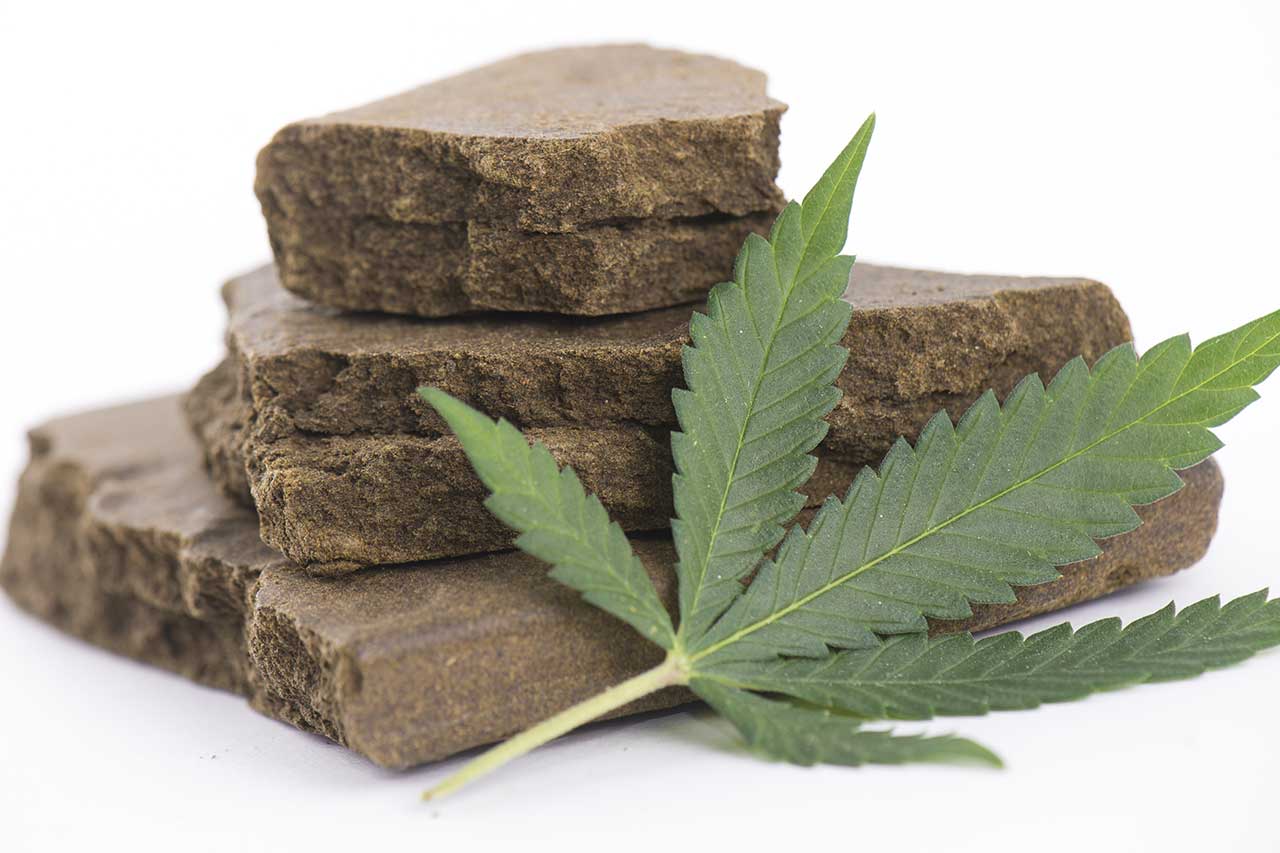What’s the Difference Between Weed and Hash?
If you don’t know the difference between weed and hash, I will assume you are a cannabis newbie. And that’s all good. Everyone has to start somewhere. Welcome to our journey where we will uncover the hidden powers and difference between weed and hash.
We’re thrilled to dive into the realm of cannabis, exploring its diverse strains, preparations, flavors, and uses.
Let’s start by clarifying the distinction between weed and hash. Weed is dried cannabis, while hash is a concentrated extract made by separating resin from buds or leaves. Both offer distinct effects and flavors, making them popular among cannabis enthusiasts.
With countless strains available, each with its own unique characteristics, we’ll explore the uplifting and relaxing experiences offered by sativa and indica varieties. Traditional hash, originating from regions like Afghanistan and India, boasts higher potency than weed.
Join us as we uncover the secrets of preparation, flavors, and ways to enjoy these potent substances. Whether you’re a seasoned connoisseur or simply curious, this article will provide valuable insights into learning the difference between weed and hash.
Difference Between Weed and Hash: Key Takeaways
– Weed and hash are both forms of cannabis, with hash being a more potent extract made from separating resin from buds or sugar leaves.
– Sativa strains of cannabis tend to produce a more uplifting, euphoric high, while indica strains are known for their relaxing effects.
– Traditional forms of hash come from Afghanistan, Morocco, and India, each with their own unique production methods.
– Both weed and hash can be smoked, vaporized, or used in edibles, and it’s important to source them from quality producers for the best experience.
Weed and Hash: What’s the Difference?
When comparing the difference between weed and hash, it’s important to understand the key differences between the two. Let’s start by discussing the pros and cons of smoking weed and hash.
Weed offers a wide range of strains, each with its own unique effects. It can provide relaxation, pain relief, and a euphoric high. However, it can also cause short-term memory loss, impaired coordination, and increased heart rate.
On the other hand, hash is much more potent, with higher levels of THC. This means that less quantity is needed to achieve the desired effects. However, hash can also have stronger side effects, such as increased anxiety and paranoia.
When it comes to health effects, both weed and hash can have similar risks, including respiratory issues and addiction potential. It’s important to consume responsibly and be aware of the potential consequences and the difference between weed and hash.
Understanding Cannabis Strains and Effects
Exploring different cannabis strains and their effects is an essential aspect of understanding the world of weed and hash. When it comes to using cannabis for medical purposes, it’s crucial to consider the specific strain that will best suit individual needs. Different strains have varying levels of cannabinoids, such as THC and CBD, which contribute to their unique effects.
Additionally, terpenes, the aromatic compounds found in cannabis, play a significant role in influencing the effects of different strains. Terpenes not only contribute to the distinct flavors and aromas of cannabis, but they also interact with cannabinoids to produce specific therapeutic effects.
Understanding the characteristics and effects of different cannabis strains, as well as the role of terpenes, can guide individuals in selecting the most appropriate strain for their desired medical benefits. These are important things to know when discussing the difference between weed and hash.
Traditional Methods of Hash Production
To delve deeper into the world of weed and hash, let’s now explore the traditional methods of hash production.
Traditional hash making techniques have been used for centuries, with historical origins in countries like Afghanistan, Morocco, and India. In Afghanistan, for example, farmers would carefully collect resin from cannabis plants and press it into solid blocks.
In Morocco, the traditional method involves sieving dried cannabis buds and leaves to separate the resin, which is then compressed into hashish balls.
In India, charas is produced by rubbing fresh cannabis flowers between the palms to collect the resin.
These traditional methods highlight the craftsmanship and expertise involved in creating high-quality hash. Understanding the historical origins of hash production allows us to appreciate the rich cultural significance and time-honored techniques used in its creation.
The Potency Battle: Weed Vs Hash
As we compare the potency and difference between weed and hash, it becomes evident that hash, with its higher THC content, reigns supreme in terms of strength and intensity. Hash typically contains 40-60% THC, while weed usually ranges from 15-30%.
The higher THC levels in hash result in more potent effects when consumed. THC, or delta-9-tetrahydrocannabinol, is the primary psychoactive compound in cannabis responsible for the ‘high’ sensation. The increased THC concentration in hash translates to a more pronounced and long-lasting high compared to weed. Users may experience enhanced euphoria, relaxation, and altered sensory perception.
However, it’s crucial to note that the effects can vary depending on the strain, individual tolerance, and consumption method. Overall, hash’s higher THC levels give it an edge in the potency battle. This is a key difference between weed and hash.
Step-by-Step Guide to Preparing Weed
Our first step in preparing weed is to gather the necessary tools and materials. To harvest weed, you’ll need a sharp pair of pruning shears or scissors to carefully cut the mature buds from the plants. It’s important to handle the buds gently to avoid damaging the delicate trichomes that contain the valuable cannabinoids.
Once the buds are harvested, they need to be dried for about two weeks in a cool, dark, and well-ventilated room. This allows the buds to slowly dry and cure, which enhances their potency and flavor. This is a massive difference between weed and hash.
After drying, the buds are placed into airtight jars for further curing, which can take several weeks to several months. Curing allows the buds to continue developing their flavors and aromas while also improving their smoothness and overall smoking experience.

Exploring Different Methods of Hash Preparation
Let’s delve into the various techniques for preparing hash, utilizing different methods to extract the potent powers of cannabis resin.
– Traditional methods of extraction: Traditional hash production techniques from Afghanistan, Morocco, and India involve hand-rubbing or sieving cannabis buds to separate resin glands, which are then pressed into solid blocks.
– Rosin pressing: This method involves applying heat and pressure to cannabis buds or hash to extract resin. It’s a solventless technique that results in a high-quality hash with a strong flavor profile.
– Bubble hash: This method uses ice water and agitation to separate resin glands from the plant material. The resin is then collected and dried, resulting in a clean and potent hash.
– BHO extraction: Butane Hash Oil (BHO) extraction involves using butane gas to dissolve resin from cannabis buds. The resulting concentrate is then purged of residual solvents, resulting in a highly potent and flavorful hash.
These methods of extraction and hash production techniques allow for the creation of a variety of hash types, each with its own unique characteristics and effects and the difference between weed and hash.
Exploring the Flavors Difference Between Weed and Hash
We will now explore the diverse flavors of both weed and hash, tantalizing our taste buds with their unique profiles. Flavors are also a big difference between weed and hash.
Understanding the terpene profiles of weed and hash is key to appreciating their flavors. Terpenes are aromatic compounds found in cannabis that contribute to its taste and aroma. Different strains of weed and hash contain varying combinations of terpenes, resulting in a wide range of flavors.
For example, some strains may have citrusy or fruity flavors, while others may be more earthy or spicy. The impact of strain selection on flavor profiles is significant. Breeders have worked to develop strains with specific terpene profiles to cater to different preferences.
Whether you prefer a refreshing, herbal taste or a complex, spicy flavor, weed and hash offer a multitude of enjoyable options for your palate.
Different Ways to Use Weed and Hash
There are numerous ways to enjoy the potent powers of weed and hash. Here are four popular ways to consume them:
– Smoking: This is the most common and traditional method. Weed and hash can be rolled into joints or smoked using pipes, bongs, or vaporizers. Smoking provides quick onset of effects and allows for precise dosage control.
– Vaporizing: Vaporizers heat weed or hash to a temperature that releases the active compounds without combustion. This method reduces the potential harm associated with smoking while still delivering the desired effects.
– Edibles: Weed and hash can be infused into various foods and beverages, such as brownies, cookies, and teas. Using them in edibles offers longer-lasting effects and a more discreet way to consume. It also allows for precise dosing. The benefits of using weed and hash in edibles include prolonged relief for medical conditions and a unique culinary experience.
– Concentrates: Weed flowers can be used to make concentrates like shatter, wax, and oils. These highly potent forms of cannabis can be smoked, vaporized, or used in edibles. Concentrates offer a stronger and more immediate effect compared to traditional methods.
Remember to start with low doses and gradually increase to find the right consumption method that suits your needs.
Importance of Quality and Genetics in Weed and Hash
To truly appreciate the potency difference between weed and hash, it’s essential to understand the significance of quality and genetics in their production. Quality control plays a crucial role in ensuring that the final product meets the desired standards of potency and safety. From the cultivation of cannabis plants to the extraction and preparation of hash, every step must be carefully monitored to maintain consistent quality.
Genetic factors also play a significant role in determining the potency of weed and hash. Different strains of cannabis possess varying levels of THC and other cannabinoids, leading to different effects. Breeders select and cultivate specific genetics to enhance desired traits, such as higher THC content.


